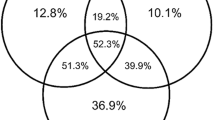Abstract
The occurrence of Protaetia lugubris, an endangered species developing in hollow trees, was studied in a network of rural avenues in northern Poland. We detected 1002 trees from nine species with hollows suitable for beetle development (25% of all trees inspected). Among them, 74 trees (7.4%) from seven species were occupied by P. lugubris. The distribution of P. lugubris was random with respect to tree species identity. The beetle preferred trees above 200 cm in circumference with a tendency towards higher occupancies of the bigger trees having circumferences above 300 cm. P. lugubris did not show any significant preferences according to hollow entrance area, exposition and road surface type. Our results indicate that P. lugubris is a generalist species colonizing all suitable hollows. Its occurrence indicates suitable conditions for many other species associated with tree cavities and decaying wood.
Similar content being viewed by others
References
Bierens H.J. 2004. EasyReg international. User guidehttp://grizzly.la.psu.edu/~hbierens/easyreg.htm.
B. Burakowski M. Mroczkowski J. Stefańska (1983) ArticleTitleChrząszcze Coleoptera. Scarabaeoidea, Dascilloidea, Byrrhoidea i Parnoidea. Kat Fauny Polski XXIII IssueID9 1–294
H. Bussler J. Schmidl (2000) Fachbeitrag xylobionte Käfer R. Bolz H. Bussler M. Dolek A. Geyer J. Schmidl (Eds) Projektgruppe Artenschutz im Wald. Artenvielfalt in verschiedenen Waldtypen und die Habitatbindung ausgewählter Charakterarten. Zoologische Ergebnisse 2000 lfu Bayern München
T.M. Caro G.O. O’Doherty (1999) ArticleTitleOn the use of surrogate species in conservation biology Cons. Biol. 13 805–814 Occurrence Handle10.1046/j.1523-1739.1999.98338.x
R. Dajoz (2000) Insects and forests. The role and diversity of insects in the forest environment Lavoisier Paris
S.J. Grove (2002) ArticleTitleSaproxylic insect ecology and the sustainable management of forests Ann. Rev. Ecol. Syst. 33 1–23 Occurrence Handle10.1146/annurev.ecolsys.33.010802.150507
R. Geiser et al. (1984) Käfer (Coleoptera) J. Blab (Eds) et al. Rote Liste der gefährdeten Tiere und Pflanzen in der Bundesrepublik Deutschland Kilda Greven 75–113
M.A. Jäch et al. (1994) Rote Liste der gefährdeten Käfer Österreichs (Coleoptera) J. Gepp (Eds) et al. Rote Listen gefährdeter Tiere Österreichs, Vol. 2 Moser Graz 107–200
R.J. Lambeck (1997) ArticleTitleFocal species: a multi-species umbrella for nature conservation Cons. Biol. 11 849–856 Occurrence Handle10.1046/j.1523-1739.1997.96319.x
S.G. Nilsson R. Baranowski J. Hedin N. Jansson T. Ranius (2002) ArticleTitleHålträdslevande guldbaggars (ColeopteraScarabaeidae) biologi och utbredning i Sverige Entomol. Tidskrift 123 81–97
Oleksa A., Ulrich W. and Gawron´ ski R. 2005. A network of rural avenues as refuges of hermit beetles (Osmoderma eremita Scop., Coleoptera). unpublished manuscript.
C. Pacyniak (1992) Najstarsze drzewa w Polsce Wyd. PTTK ,,Kraj“ Warszawa
J. Pawłowski (1961) ArticleTitlePróchnojady blaszkoroż ne w biocenozie leśnej Polski Ekologia Polska 9 355–437
T. Ranius (2002) ArticleTitle Osmoderma eremita as an indicator of species richness of beetles in tree hollows Biodiv. Cons. 11 931–941 Occurrence Handle10.1023/A:1015364020043
T. Ranius N. Jansson (2000) ArticleTitleThe influence of forest regrowth, original canopy cover and tree size on saproxylic beetles associated with hollow oaks Biol. Cons. 95 85–94 Occurrence Handle10.1016/S0006-3207(00)00007-0
T. Ranius S.G. Nilsson (1997) ArticleTitleHabitat of Osmoderma eremita Scop. (Coleoptera: Scarabaeidae), a beetle living in hollow trees J. Insect Cons. 1 193–204 Occurrence Handle10.1023/A:1018416000766
Ranius T., Aguado L.O., Antonsson K., Audisio P., Ballerio A., Carpaneto G.M., Chobot K., Gjurašin B., Hanssen O., Huijbregts H., Lakatos F., Martin O., Neculiseanu Z., Nikitsky N.B., Paill W., Pirnat A., Rizun V., Ruicănescu A., Stegner J., Süda I., Szwałko P., Tamutis V., Telnov D., Tsinkevich V., Versteirt V., Vignon V., Vögeli M. and Zach P. 2005. Osmoderma eremita (Coleoptera: Scarabaeidae: Cetoniinae) in Europe. Anim. Biodiv. Cons 28: 1–44.
J. Schmidl (2003) Die Mulmhöhlen-bewohnende Käferfauna alter Reichswald-Eichen. ArtenbestandGefährdung, Schutzmaßnahmen und Perspektiven einer bedrohten Käfergruppe. – Unveröff. Gutachten im Auftrag des Bund Naturschutz Kreisgruppe Nürnberg Bufos Nürnberg
M.C.D. Speight (1989) Saproxylic invertebrates and their conservation Council of Europe Strasbourg
Statsoft Inc. 2001. Statistica (data analysis software system). Vers. 6. www.statsoft.com.
Ulrich W. 2003. Sample – a FORTRAN program for taking series of random samples. www.uni.torun.pl/~ulrichw.
Ulrich W. and Ollik M. 2005. Limits to the estimation of species richness: the use of relative abundance distributions. Div. Distr. 11: in press.
Author information
Authors and Affiliations
Corresponding author
Rights and permissions
About this article
Cite this article
Oleksa, A., Ulrich, W. & Gawroński, R. Occurrence of the marbled rose-chafer (Protaetia lugubris Herbst, Coleoptera, Cetoniidae) in rural avenues in northern poland. J Insect Conserv 10, 241–247 (2006). https://doi.org/10.1007/s10841-005-4830-1
Received:
Accepted:
Issue Date:
DOI: https://doi.org/10.1007/s10841-005-4830-1




